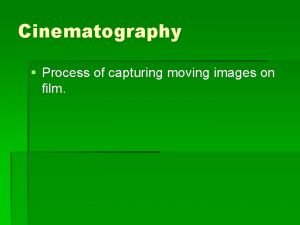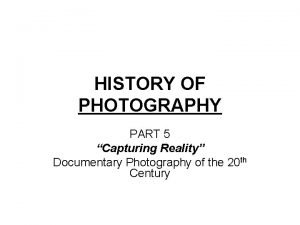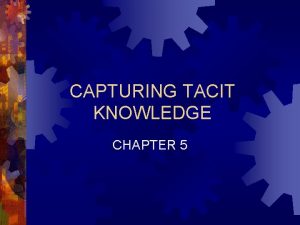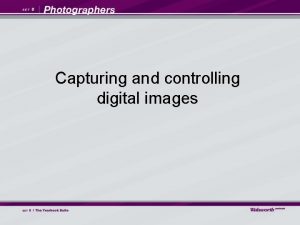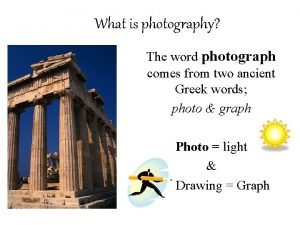When it comes to capturing a captivating photograph


















- Slides: 18


When it comes to capturing a captivating photograph, many people may believe that it's all about light. While illumination is important, darkness is an equally compelling component. Showcasing the shapes and darkness shadows cast is a surprising way to enhance a composition. Here, we explain the ways in which you can master the art of shadow photography.


First of all, what are shadows? A shadow is the contour created when an object or person blocks rays of light from reaching a surface. The shape of a shadow changes based on its relationship with its light source. The distance, angle, and size of the source work together to determine the intensity, form, and scale of the shadow.


Shadow Role While this may seem to be a fairly obvious explanation, a shadow's role in photography is often fuzzy. Silhouettes and reflections can be mistaken for shadows. Like shadows, silhouettes are formed by restricted light. Similarly, reflections materialize as projections on a surface formed by an object. Though conceptually similar and equally effective, both phenomena are independent subjects in the field of photography.



How can shadows enhance a photograph? Shadows can enrich a photograph in numerous ways. In some cases, photographers utilize them as subtle, accentuating details. They are not the focal point of the piece. Instead, they strengthen the photo by adding a sense of balance, contrast, or dimensionality to the composition.


Experimentation Similarly, photographers also often deliberately experiment with the effect of shadows on subject matter. By casting shadows directly onto their subjects, they are able to alter their appearance and experiment with texture, pattern, and even emotion. In such cases, the shadow's role is obvious, deliberate, and of significant visual importance.


Shadows as Focal Points Finally, some photographers employ shadows as the focal points of their pieces. In addition to exhibiting the photographer's avant-garde approach to the craft, this unique use of shadows prompts viewers to see the often overlooked visuals in a new light. Ultimately, as subjects, they take on a life of their own.


How can I expertly capture shadows? To master the art of shadow photography, there a few important steps to take. 1. Decide how you aim to use the shadows. Do you want them to subtly accentuate a subject? Or do you wish to highlight their effect on it? Perhaps you want to create a composition entirely focused on them. The choice is yours! 2. Consider the positioning and quality of your light source. If it's far away and faint, the shadow will be softer and less defined than a closer, stronger illumination. Similarly, the direction of the light directly affects the shape of a shadow. If an object is lit from the front (or front-lit), the shadow will be difficult to capture on camera, as it will fall behind the subject. Contrarily, if the object is backlit, it will cast a shadow toward the front of the composition. This technique can also be tricky, however, as the light can cast a lens flare. Fortunately, this can be remedied with certain tools, including a lens hood (see a selection on Amazon). The best approach, then, is to position or capture the light at an angle so that the shadow forms to the object's left or right. In this case, the object is side lit.

How can I expertly capture shadows? 3. Pay attention to placement. Be aware of both the object that will create the shadow and the surface it will be cast upon. Like the positioning of the light source, this can drastically alter your composition. The key is to experiment. 4. Be creative—especially with color! Black and white photos can emphasize the contrast of shadows, while color images capture the unique tones that comprise a shadow. Believe it or not, they're not always a monotonous black or grey.


Criteria Include 20 photographs of shadows Variety- shadow as focal point and as a product Create a collage using a collage app like: Layout Live Collage New one of your choice? Submitted on Drop Box OR i. Drive
 First comes love, then comes marriage
First comes love, then comes marriage 5 core customer and marketplace concepts
5 core customer and marketplace concepts Qualitative research techniques to measure brand equity
Qualitative research techniques to measure brand equity Marketing approach to demand measurement
Marketing approach to demand measurement Automatic data capture
Automatic data capture Asr utility tree
Asr utility tree The process of capturing moving images on film
The process of capturing moving images on film Input devices images
Input devices images Capturing marketing insights
Capturing marketing insights Capturing quantities
Capturing quantities Capturing customer mindset
Capturing customer mindset Capturing quantities
Capturing quantities Data capturing workshop
Data capturing workshop Capturing reality documentary
Capturing reality documentary Danone
Danone Capturing quantities
Capturing quantities Creating and capturing customer value
Creating and capturing customer value Marketing concept
Marketing concept Pricing: understanding and capturing customer value
Pricing: understanding and capturing customer value






